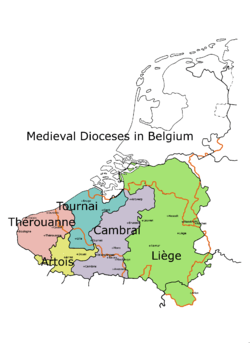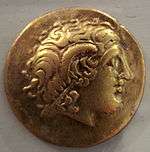Morini
The Morini were a Belgic tribe of northern Gaul. They were mentioned in such classical works as the Commentarii de Bello Gallico written by Julius Caesar.[1] They became an established part of the Roman empire with the coastal parts of the present-day départment of Pas-de-Calais in northernmost France, bordering on the English Channel. A generation after their entry into the Roman Empire the writer Vergil described them poetically as the remotest of people.[2]
Etymology
The tribe's name Morini is thought to be Celtic meaning "those of the sea". It is apparently derived from the suffix -no- (like other Celtic peoples Ruteni, Santoni, Turini or Tigurini) and the Celtic word mori meaning "sea", mentioned in the Vienna Glossary as more translated into Latin as mare "sea". Another derived word morici exists and is translated into Latin as marini "sailors". The variation morici is found in Aremorici "those who live in front of the sea" (Celtic are "in front of", "along").[3] Morini represents another variation. Mori is a close relative of Welsh môr, Breton and Cornish mor, Irish muir. The Indo-European prototype was perhaps *móri that gave also birth to Germanic *mari: English mere, German Meer, etc..Old Slavic morje, etc.[4]
Location

One of the most important cities of the Morini, was Gesoriacum, modern Boulogne-sur-Mer, called Bononia by Zosimus in late antiquity, and Bonen in the Dutch language. Itius Portus or Portus Itius was also the name of a Morini port city, generally considered to be either Wissant or Boulogne.
The administrative capital or civitas during the Roman Empire was Tarwanna or Tervanna, modern Thérouanne (Terwaan in Dutch), today in France, inland from Boulogne. But in later imperial times Boulogne is referred to as a civitas itself, implying either that it had supplanted Thérouanne as civitas of the Morini, possibly after a partial destruction in 275, or else that it had become administratively separate, perhaps because of its military and economic importance.[5]
Thérouanne is only approximately 30km to the southwest of Cassel, which was the Roman civitas of the neighbouring Menapii, whose territory stretched northwards to the river deltas of the Scheldt, Meuse and Rhine, and approximately 65km northwest of Arras, which was the civitas of the Atrebates. To the south of the Morini and Atrebates were the Ambiani, whose civitas was at modern Amiens.
Strabo in his Geographica, describes the country of the Morini as being on the sea, close to the Menapii, and covered by part of a large forest with low thorny trees and shrubs. He also reports that before Roman conquest, the Morini and their neighbours in these forests "fixed stakes in various places, and then retreated with their whole families into the recesses of the forest, to small islands surrounded by marshes. During the rainy season these proved secure hiding-places, but in times of drought they were easily taken."[6]

Culture
Caesar described the Belgae, including the Morini, as Gauls who had different language, customs and laws compared to the central part of Gaul which he called Celtic.[7] He also mentioned that he had heard that the Belgae had some Germanic ancestry from east of the Rhine.[1] Place names and personal names clearly show that the Belgae were heavily influenced by Celtic language, but some linguists such as Maurits Gysseling, have argued based on placename studies that they spoke either a Germanic language, or else another language neither Celtic nor Germanic.[8] Edith Wightman reads Caesar to make a distinction between the core of the Belgae included the Suessiones, Viromandui and Ambiani, placing the Morini, Menapii, Nervii, and other northern tribes in a "transition zone" which may have been more Germanic.[9] She proposes that coin evidence indicates that these northern tribes were probably bound to an alliance with the core group in the generations before Caesar's arrival, and that the Morini may have been a relatively new and loosely bound member of the alliance.[10]
Pliny the Elder remarked that the Morini cultivated flax and used linen to make sails.[11] The area was also known for exporting wool, geese, pork, salt, and garum.[12]
In late classical times Zosimus implied the Germanic character of the city, calling it Bononia germanorum.
History
Caesar was very interested in that part of the Morini territory, which is where the crossing of the sea to Britannia was "the shortest".[13] The Morini had several harbours of which Portus Itius, was only one.[14]
The tribe counted some pagi (subregions), which, apparently, could make their own decisions.[15] The Morini fled into or behind the marshes and became unreachable for the Roman army. In 56 BC, when autumn was very wet, this tactic worked. The year after, which was much dryer, it failed.[16] The Morini participated together with other coastal people (Lexovii, Namnetes, Ambiliati, Diablintes and Menapii) and tribes from Britain, in the uprising of the Veneti.[17]
Caesar wanted to induce fear in the northern Morini so "that they wouldn't attack him."[18] The territory of the Morini and Menapii was well protected by marshes and woodland and suited for guerrilla tactics. The dangers outweighed the benefits of subduing those economically less interesting regions. In 55 BC Labienus tightened the Roman grip upon the strategically more important western side of the Morini tribal areas.[19] In 54 BC Caesar let one legion, under the command of legate Caius Fabius, hibernate there.[20] In 53 BC the Morini were joined most probably with the Menapii under the command of the Atrebate Commius.[21] During the great Gallic rebellion led by Vercingetorix, the Morini, like many other Gaulish tribes, sent a contingent of some 5000 men to the relief force which had to liberate Alesia.[22]
Although Caesar fought the Morini, he managed to conquer only a part of their territory around Calais. The rest of the Morini were annexed by emperor Augustus between the years 33-23 B.C.. Their tribal lands became part of the Roman province of Gallia Belgica, forming one district together with the Atrebates and Ambiani.[23]
In late classical times, Bolougne (Bononia) became part of the coastal defense administration known as the "Saxon shore", and was probably administered separately from Thérouanne.
The area was converted to Christianity by Saints Victoricus and Fuscian, but the region was re-evangelized by Saint Omer in the seventh century. Thérouanne became the capital of a medieval diocese which included the old territories of the Morini and Atrebates, as well as part of the old Menapian civitas.
See also
References
- 1 2 Julius Caesar, Commentarii de Bello Gallico 2.4
- ↑ Wightman, Edith Mary (1985), Gallia Belgica, University of California Press, page 29. See Aeneid VIII 671
- ↑ fr:Pierre-Yves Lambert, La langue gauloise, éditions errance 1994. p. 34.
- ↑ Xavier Delamarre, Dictionnaire de la langue gauloise, éditions errance 2003.
- ↑ https://books.google.com/books?id=aEyS54uSj88C&pg=PA204 Missing or empty
|title=(help) - ↑ Geographica IV 3
- ↑ Julius Caesar, Commentarii de Bello Gallico 1.1
- ↑ See Belgae.
- ↑ Wightman, Edith Mary (1985), Gallia Belgica, University of California Press, page 12.
- ↑ Wightman, Edith Mary (1985), Gallia Belgica, University of California Press, pages 20 and 29.
- ↑ Natural History XIX.2
- ↑ G. P. A. Besuijen, Rodanum: A Study of the Roman Settlement at Aardenburg and Its Metal Finds page 11 and page 33
- ↑ Caes., D.B.G., IV 21.3 - previously, Caesar knew only the crossing from the Veneti region
- ↑ Caes., D.B.G., V 2.3; Strabo, Geographia IV 5.2.
- ↑ Caes., D.B.G., IV 22.1, 5.
- ↑ Caes., D.B.G., III 28-29; IV 38. In book III Caesar writes about "uninterrupted woodlands and marshes". In Book IV he notes that the Morini had withdrawn in the marshes and the Menapii in the woods (IV 38.2-3).
- ↑ Caes., D.B.G., III 9.10
- ↑ Caes., D.B.G., IV 22
- ↑ Caes., D.B.G., IV 38.1-2
- ↑ Caes., D.B.G., V 24.2
- ↑ Caes., D.B.G., VI 8.4 en VII 76.2
- ↑ Caes., D.B.G., VII 75.3
- ↑ Wightman, Edith Mary (1985), Gallia Belgica, University of California Press, page 63.
- Jacques Malbrancq: De morinis morinorom rebus, Tournai, 1639.
